Xiaomi has perfected the art of pleasantly surprising its fans and followers, and it has done so unveiling great smartphones with striking specs at unexpected prices. This strategy has also played a major role in the growth and success that Xiaomi has achieved in India. But this time around, the company has pleasantly surprised everyone by launching a power-packed smartphone for a totally unexpected price. The Poco F1 by Xiaomi is a stunner of a smartphone that comes with a rich and vibrant specs sheet and my jaw still hurts from hanging loosely after first learning about the price.
The Poco F1 not only puts a mouth-watering platter of supreme capabilities, it does this in a non-flamboyant manner. At the starting price of only Rs 20,999 (on Flipkart), the Poco F1 not only shakes up the market of flagships and flagship killers but is also capable of bringing about a paradigm shift in our understanding of the word, “flagship”. Besides great internals, it does try to lean into the world of premium smartphone and scores well for trying.
And, there’s a lot more to know about the smartphone, so let me start by telling you about the specifications of the Poco F1.
Poco F1 Specifications
Poco F1 comes with some robust specification on paper and before we start digging into the features and performance, let me tell you about the hardware that this smartphone is crammed with.
| Display | 6.18 inch, FullHD+ (1080 x 2246 pixels) IPS LCD |
| Memory | 6/8 GB RAM |
| Storage | 64/128/256GB ROM + Hybrid MicroSD slot, up to 256 GB |
| Processor | Qualcomm Snapdragon 845, Octa-Core (4*2.8 GHz Kryo 385 Gold & 4*1.8 GHz Kryo 385 Silver) with Adreno 630 |
| Camera | 12MP f/1.9 + 5MP f/2.0, LED Flash, 4K & Slo-mo Support, AI |
| Front | 20 MP f/2.0, AI Portrait Mode |
| OS+UI | Android 8.1 + MIUI for POCO |
| Battery | 4,000mAh with Qualcomm's Quick Charge 3.0 |
| Sensor | Fingerprint sensor, IR Face Unlock, accelerometer, gyroscope, proximity sensor, compass |
| Bluetooth | 5.0 with AptX |
| WiFi | Wi-Fi 802.11 a/b/g/n/ac, dual-band |
Box Contents
Unlike the fanciful Poco F1, its box packaging is very plain and draped in the characteristic yellow+black color scheme, which has long been the universal color scheme of muscle cars and might also remind you of Bumblebee. Nothing special, though, and in the basic packaging you get the following things:

- Poco F1 handset
- USB-C cable
- Poco 18W Quick Charger
- SIM ejector
- TPU protective case
- User manual and warranty guide
Design and Build
With the emphasis on durability and performance, Poco F1 is outfitted with a plain polycarbonate back. The choice of this limbo design, as per the company, is a voluntary decision which directs the focus to other features including a good camera, besides powerful specifications. The band covering the edges appears to be made out of brushed metal but that too is made of plastic.
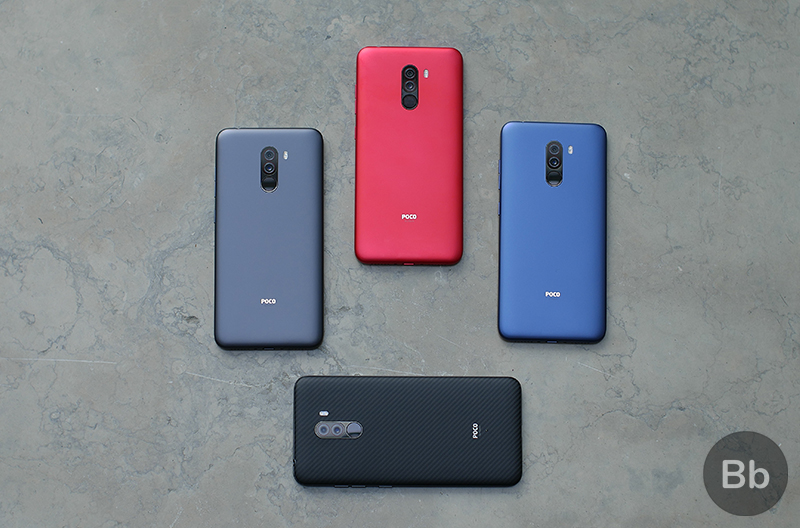
If you’re all for looks, you can spend Rs 1,000 over the top variant and choose the “armoured edition” with three layers of Kevlar, which should hoist your spirits and is likely to make the Poco F1 appear slightly premium. Separate volume up and down buttons and the power button are placed along the right edge of the F1 and the primary speaker and the USB-C port lie at the bottom. The buttons placement is convenient and the gap between volume and power controls makes it easy to differentiate between buttons. Had the power button been textured it would have made it more usable. The top of the Poco F1 carries a headphone jack while the Hybrid SIM tray is placed at the top left of the smartphone.

The simplistic construction invokes a feeling of balance and zen which is maintained when you take a look at the cameras. The dual camera setup, as well as the circular fingerprint scanner, is aligned along the center line and gladly there’s no camera bump. The design represents Pocophone’s sense of originality and is not congruent with its standard philosophy of blatantly aping the iPhone. This is probably because Xiaomi has launched the smartphone in more than 50 markets across the globe and design will play a key role in the brand’s identity.
On the front, you get a 6.18-inch LCD display with a notch on top of it. The Poco F1 features IR face sensors placed up top. While the choice of LCD over AMOLED is evidently because of the super-competitive price, it also adds to the overall thickness of the smartphone. The chamfering of edges also cuts down on the ease of handling compared to Mi 8 which comes with an AMOLED display. However, that can be cured with a back cover such as the one bundled in the package. Lastly, there’s a tiny notification LED intersecting the bottom edge.
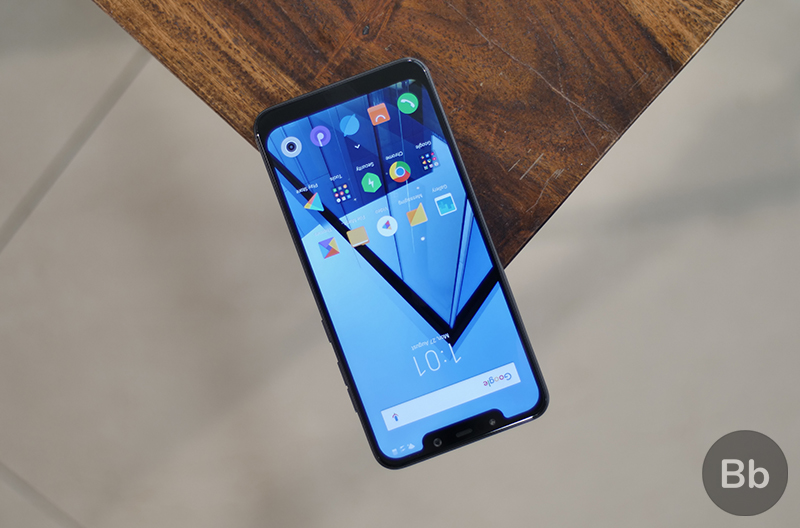
Despite the polycarbonate body, there isn’t much flex and the Poco F1 is not likely to fall prey to a bend-gate anytime soon. Nor will the back shatter if you drop the phone and it feels sturdy enough to handle gentle drops well – although I haven’t had the courage to drop it. Lastly, features like NFC, Wireless Charging, any sort of waterproofing are absent but those features are not even expected in this price range.
Overall, I am convinced that the company’s choice of polycarbonate over glass or metal does not hamper the durability of the Poco F1, the overall build feels solid and sturdy, even if not very premium.
Display
Coming the display on the Poco F1, it uses a 6.18-inch LCD display which is sufficiently bright and offers good colors. Xiaomi claims that the display supports 84% of the NTSC color gamut and gets as bright as 500 nits. I can confirm that the display is easily readable even under direct sunlight. It is protected under Gorilla Glass 3, which is another example of cost-cutting considering the sixth gen is already available.

But don’t take me wrong – the display gets amply bright and has a very vivid color scheme. Like most other Xiaomi devices, you also get the ability to optimize its color temperature as per your preference. Like other LCDs, colors appear slightly washed out when the display is looked at from sharp angles, but otherwise, it does not disappoint in any way. The colors are well-saturated and would not affect your viewing experience except when looking from those awkward angles.
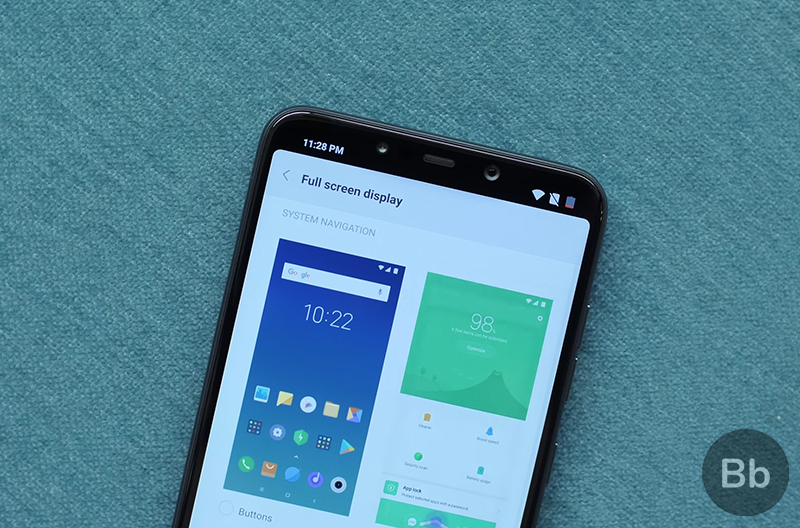
If you’re not a big fan of the notch, you can turn it off. But I personally prefer keeping it on simply because I have come to like it and enjoy the extra real-estate that it brings to the display. However, in order to place the infrared face unlocking equipment, Xiaomi has stolen space from the display and the area around the notch is mostly occupied by battery and signal status and the clock – leaving no room for notification badges or any other indicator.
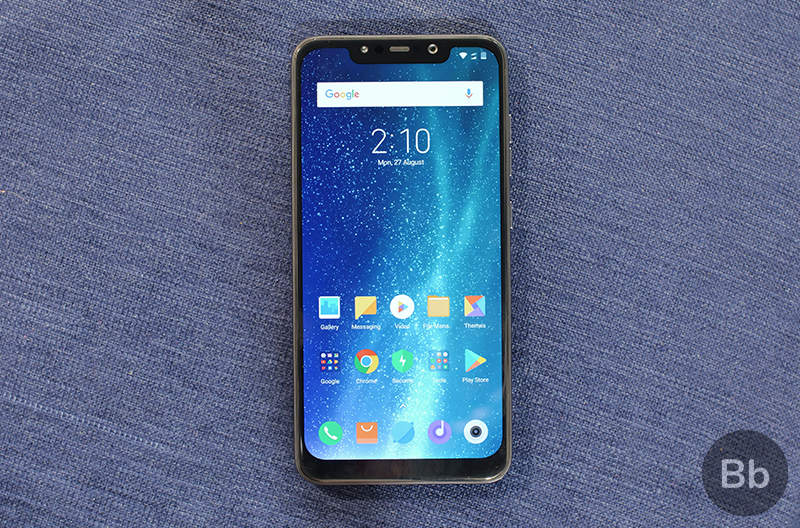
The lower corners of the display are too round for my liking and I’m totally not into curves of this kind. These corners obstruct viewing of items on the screen and it feels like the cover glass and not the screen itself is curved. While the shortcoming does not impact the performance mostly, it is poorly optimized for games and I honestly despise this aspect about the Poco F1.
Overall, I find the Poco F1’s display sufficiently bright and detailed while the colors are pretty accurate. I just wish that Pocophone had spent more time and effort in optimizing the lower rounded corners with at least popular apps like PUBG.
Performance
With the all the (literally) cut corners aside, the Poco F1 is genuinely a superb performer. The onboard Snapdragon 845 and up to 8GB of RAM unleash the beast behind an unsuspecting facade. We’ve seen this chipset rending blazing fast performance on the likes of OnePlus 6, Xiaomi Mi 8, and Vivo NEX. Both – on paper and in real-life – the Snapdragon 845 is the fastest processor but does that ensure unbeatable performance on the Poco F1?
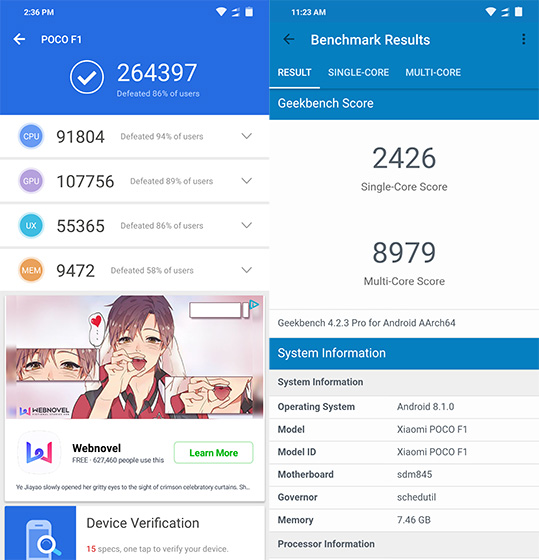
Well to an extent, yes. In terms of AnTuTu benchmark scores, the Poco F1 falls short of the Samsung Galaxy S9+, Asus Zenfone 5Z, and even the OnePlus 6 by a small margin. As per Geekbench results, all the three affordable Snapdragon 845 smartphones have a close brush.
Note: We’re using the 8GB variant of the Poco F1 and the performance of the 6GB version is likely to be slightly below this variant.
In real-world usage, the Poco F1 refutes critics by putting up completely lag-free performance and no shuttering at all. In my week-long usage of the Poco F1, I have not encountered any issue in day-to-day tasks except for inaccurate support for the notch.
In terms of security, the Poco F1 comes with IR face unlocking beside the regular fingerprint and the mechanism is pretty accurate, fast, and fairly reliable.

-
Gaming
The gaming performance on the Poco F1 is simply amazing and anyone unaware of its prowess can easily mistake it for a much expensive smartphone. I have been gaming extensively on the smartphone with titles such as PUBG Mobile, Mortal Kombat, PES 2018, Shadowgun Legends, and Asphalt 9, and have never observed even a split second of lag.

Gameplay is really smooth and incredibly charming. I, however, did not enjoy the fact that the screen crops out essential buttons placed along the lower corners. If you can forgive the Poco F1 but aside from this drawback, I’ve loved every moment of gaming on this.
I just wish the Pocophone had taken the effort of adding a Gaming mode so that the resources could be utilized even more properly, but hopefully that should come in future updates.

-
LiquidCool Technology
Poco F1 brings a unique proposition in form of the liquid cooling setup that it features. Up until now, the technology has mostly been limited to high-performance PCs and premium smartphones including the Galaxy S and Note series. The heat sink on the Poco F1 prevents the phone from reaching unbearable high temperatures and also helps it cool down pretty fast.
Unlike the sophisticated setup on gaming PCs, the Poco F1 uses a simple pipe which transmits the heat from the hotter to the cooler parts of the smartphone. Effectively, this results in a temperature difference of nearly 4°C to 8°C. You can read more about our test of the heat dissipation mechanism.

The Poco F1 is clearly a master performer and while it may fall slightly short of more expensive devices such as the OnePlus 6 or Asus Zenfone 5Z, this is probably because of MIUI for Poco, which still feels somewhat unfinished and is expected to improve over time. Lastly, I am really impressed by the liquid cooling mechanism on the smartphone.
Speakers
One of the quirks that the Poco F1 comes with is its dual speaker setup, which is similar to the Huawei P20 Pro in terms of operation. It is split between the main speaker at the bottom and a secondary speaker under the earpiece of the Poco F1. My early thoughts about the speakers were that the setup is very loud and clean.
With the passage of time, I have noted that the speaker has a decent amount of clarity. While the Poco F1 challenges relatively more expensive devices, expecting the sound to match those devices will deliver you to the harbor of disappointment. Further, the secondary speaker sounds tinny and very feeble compared to the main one.
Cameras
Poco F1 is graced by a dual camera setup, which thankfully does not protrude uncomfortably. The rear camera comprises a 12-megapixel Sony sensor, which is the same as the Mi MIX 2S and the Mi 8, and a 5-megapixel Samsung sensor which is used for sensing the depth in bokeh shots. The hardware is complemented by an AI which is capable of identifying 200 different scenes and improving the photography skills of the Poco F1.
-
Daylight
Day light shots are full of detail and have accurate colors. The same holds good when we look at pictures taken in natural lighting but indoors. In well-lit images, there’s sufficient detail which is equated with a good and natural reproduction of colors.
The pictures captured by the smartphone have a punchy saturation which is achieved without any exaggeration.
-
Night & Artificial Lighting
The rear camera does a commendable job of keeping the details intact, even in a dim ambiance. The Poco F1 uses the same camera app as other Xiaomi smartphones with standard features including an AI beautification mode and a manual mode. A slight amount of noise in color accuracy creeps in as the amount of light in the frame decreases.
It fares impressively well against other smartphones in its category including the Honor Play, Mi A2, and the Nokia 7 Plus and gives a tough competition to the OnePlus 6.
-
Portrait Mode
The Poco F1 also features a portrait mode which differentiates between background and foreground objects impeccably. The AI can be seen to improve the contrast of images but some images also appear overblown.
-
Selfies
The front of the Poco F1 features a 20-megapixel sensor which, too, picks up good details and decent exposure while taking selfies. Besides rich details and great color of selfies, the Poco F1 does exceptionally well in terms of selfie portrait and easily beats competitors in this area. The edge detection is insanely accurate, especially in cases of bright lighting.
Lastly, you can add live filters to the pictures while another nifty feature informs you when the camera lens is dirty; however, I did not find it working very well in case of sweat smudges. You can take a look at our detailed camera review of the Poco F1 for better insights.
-
Video
With 4K video at 30fps and slo-mo video at up to 240fps, there isn’t much to ask for from the Poco F1 in this price range. Videos turn out to have sufficient detail in bright lighting and decrease with exposure. Take a look for yourself at 5:53 (I’ve pointed to it already):
The lack of OIS is very much felt but EIS tries its best to reduce the shaking of the frame. Bottomline – you still get a great video quality for the price.
Overall, the cameras on the Poco F1 are worthy of your attention and should be able to serve you well in nearly all lighting conditions. The dynamic colors and impeccable sharpness prompted me to click many more random pictures than I usually do.
-
How Does The Poco F1 Camera Fare Against Competitors?
The Poco F1 is easily capable of putting its biggest competitors to shame, thanks to its great camera. In day and night light alike, the sharpness of images remains intact and the only trade-off is in the quality of color reproduction. I have been fairly impressed by the camera’s performance and just wish that the AI was a bit softer with natural objects.
Here are some of the shots we used for comparison:
The comparison of the camera among Poco F1, OnePlus 6, Honor Play, Mi A2, and Nokia 7 Plus resulted in a neck-to-neck performance between the first two of the bunch. The Honor Play had a better camera than the Mi A2 and the Nokia 7 Plus but it ravaged things by overexposing the colors.
Overall, the accurate bokeh mode and profound details make me feel that Poco F1 is the best camera smartphone of the lot with the OnePlus 6 being only better in terms of capturing skin texture more elaborately.
Software
Pocophone has taken the pain of creating a dedicated version of MIUI, called “MIUI for POCO”, for the Poco F1 which is based on Android 8.1. This is an intermediate between the regular, loaded version of MIUI and stock Android. What seems to be backing this decision is the intention of making the interface less bloated and more fluid besides offering a visually clean interface. Being a sucker for stock Android, I prefer this version of MIUI much better.
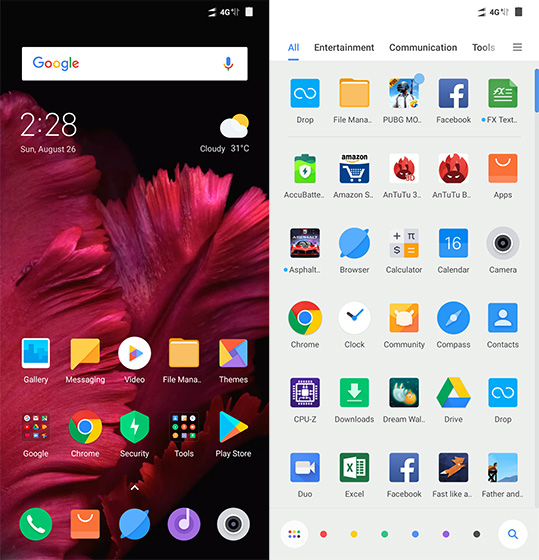
MIUI for POCO is typically MIUI with a feature-rich launcher which sports a cleaner notification shade and quick settings panel. Among the features, you get in the launcher is the much-needed app drawer. The launcher automatically sorts apps based on their category and also lets you sift through them based on the color of the icons. There’s also a search bar while you can also very easily hide apps from the app drawer. You also get a relatively minimal Settings interface – although without any change in the available options.

Currently, there is no way to change the orientation of the icons or size of the icon grid, but you get support for third-party icon packs. At the same time, if you fancy dressing your phone with cute wallpapers and dandy colors, there is support for MIUI themes.
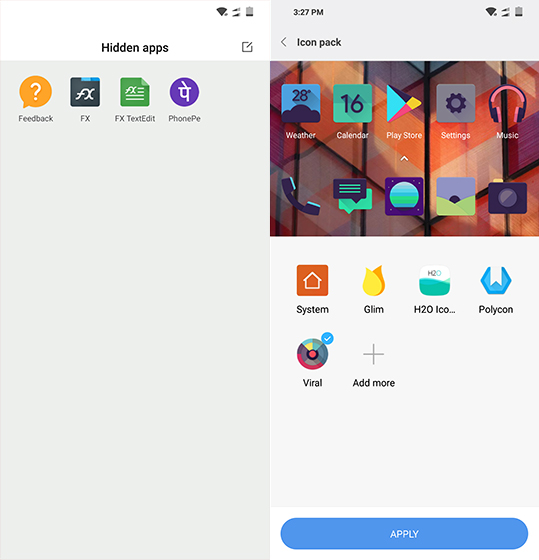
As of now, it is difficult to judge if the launcher actually enhances the performance of the Poco F1 and but there are some issues that have been peeving me. The interface does not seem very well optimized for the big notch as you don’t see notification badges because the available screen area is crowded by the battery and signal status icons.

This is especially annoying when you’ve to quickly take a glance at which apps are notifying you instead of having to expand the notification panel. Moreover, while you can also activate elements such as network speed, icons for network and other connections push it out of the visible area.

This brings me to another peeve I have with the Poco F1 and that is, the smartphone does not allow scaling in YouTube videos – a feature present even on Redmi Note 5 Pro. So despite the wider screen, you’re limited to viewing videos in their native aspect ratio and a big area of the display is wasted.
I expect Pocophone to take a look at these issues as the company has already announced a reward programme for beta testers. In terms of updates, Pocophone says that the security updates will be rolled out at least every quarter while it will strive to reduce this gap as much as possible.
The interface of the Poco F1 brings about a significant improvement in terms of smoothness by getting rid of useless animations and maintaining an overall sense of minimalism. However, the system could use some improvement to make the interface more fluid and agile. We expect these issues to be rectified with the Android Pie update which has been promised to arrive by the end of this year.
Battery
Another area where the Poco F1 outpaces its competitors is the capacity of its battery. The smartphone uses a 4,000mAh battery which comes with the benefit of quick charging. On heavy usage, the battery lasts for almost 16 hours with a screen-on-time of anywhere between four and six hours. On moderate usage, the smartphone can manage to last for more than 24 hours, which is impressive.
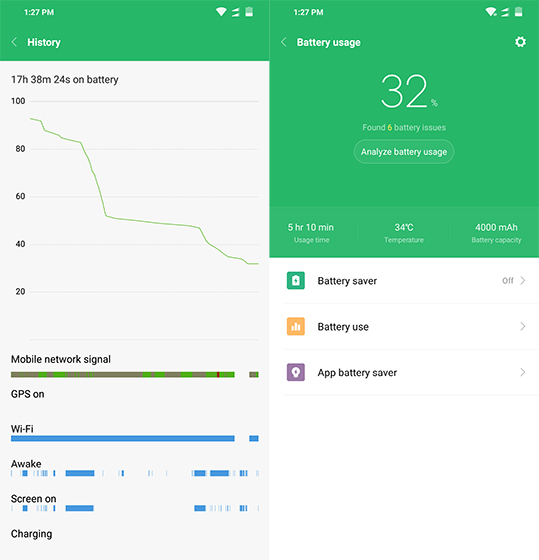
Beefing up the battery takes 120 minutes while half of the battery gets refueled in 50-55 minutes, thanks to Qualcomm’s Quick Charge 3.0. The battery app also features optimization options which can be used to put apps to sleep or under restriction when they’re not being used and protection at more than 90% battery capacity prevents the Poco F1 from heating.

Overall, the battery performance is great but the extra capacity compared to the Honor Play and OnePlus does not actually ensure a significant bump in the battery backup which is something that I was expecting. Quick charging is a nifty addition which results in a charging time of nearly 2 hours, which we hope to decrease with coming update.
Connectivity
On the connectivity front, you get Bluetooth 5.0, Wi-Fi, and dual VoLTE. Pocophone has promised higher speeds and better connectivity in lieu of 4G+, or 4G with MIMO (multiple-input-multiple-output), on the Poco F1. I did observe better connectivity, especially while traveling in the Delhi Metro and in a side-by-side comparison with the Galaxy Note 9 and Mi A2, the Poco F1 was the first to connect to a speed test. However, there was only a marginal increase in the speed of the connection.

Further, dual 4G/VoLTE ensures that you can continue using 4G on the Poco F1 even when you’re on a call. Lastly, the process of switching the primary SIM for data is seamless and quick.
Poco F1: A Newly Defined Flagship
The Poco F1, with its impressive specifications, is easily one of the highest values for money. In spite of the areas in which it lags, I’m sure it can put up tough competition the OnePlus 6 and even other smartphones in the sub-50k range. Apart from the great performance, the Poco F1 features highly adept cameras with the goodness of AI. For the price of Rs 20,999, it easily puts its prime competitors – Honor Play, Mi A2, and Nokia 7 Plus – to shame. Then quirks like liquid cooling and a striving dual speaker put it ahead of the league.
Poco F1 is capable of bringing about a paradigm shift in our understanding of the word, “flagship”.
While my experience with the Poco F1 has been tremendous and full of attractions, there are some vices which I feel could disappoint certain users. But, let’s take note of the virtues of the Poco F1 before addressing its vices.
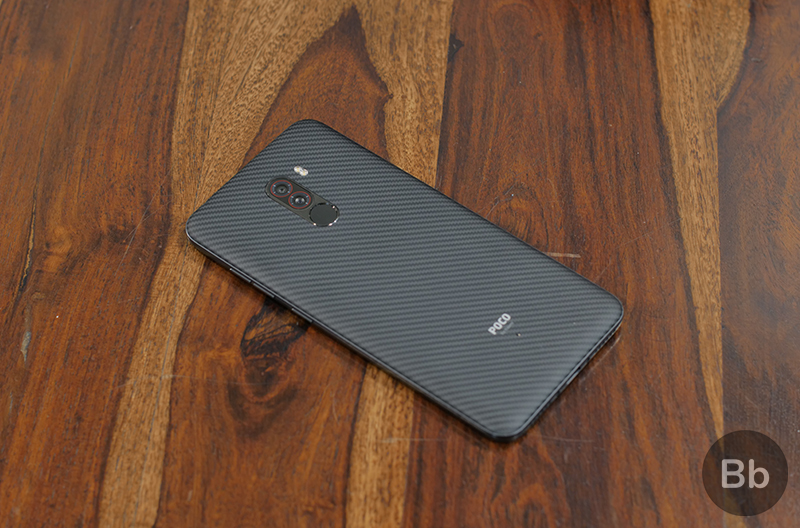
Pros
- Solid build
- Bright display
- Flagship-level performance
- Liquid cooling
- Drool-worthy cameras
- IR face unlock
- Massive storage with micro SD support
- 4G+
- Super price-effective
Cons
- Older gen Gorilla Glass
- Tinny secondary speaker
- Poor UI optimization for rounded corners
- No dedicated gaming mode
SEE ALSO: Honor Play Review: The Best Budget Phone for Gamers?
Poco F1: A Pocket-Friendly Flagship Slayer
Poco F1’s major competitors, Honor Play (starts at Rs. 19,999), Nokia 7 Plus (₹25,999), and Mi A2 (Rs. 16,999), easily bite the dust while the F1 comes out as a clearcut winner. In spite of its few drawbacks, I believe that the Poco F1 is a super powerful device which can easily pose a threat to devices such as the OnePlus 6. I also feel that the smartphone, if produced and sold in sufficient volumes, can bring about a change in the way we perceive the premium segment of current the smartphone market. With so many reasons to make merry, the price of the Poco F1 leaves no scope for any complaint.

So, that’s what we think of the Poco F1 and we will continue to update this article as we experience the device even more. What are your thoughts? Did I miss something? Share your views in the comment section below while I return to gawking over the new flagship of the masses.
Buy the Poco F1 from Flipkart (starts at Rs 20,990)












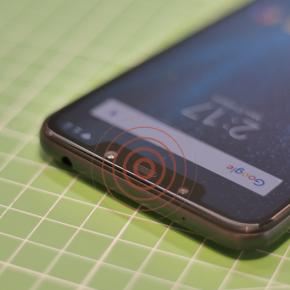


















































when. will be a upgrade phone to this poco f1 to be going to launch any imformation and impressions
Hi Navroj, you can use this guide: https://beebom.com/poco-f1-stable-miui-10-update/
Hey guys!
One question:
Poco: (6/128) – 330€
Honor Play: (6/64) -320€
Which one would you recommend for overall?
Thx and best wishes!
Yes It Is Flagship Of Masses 😀